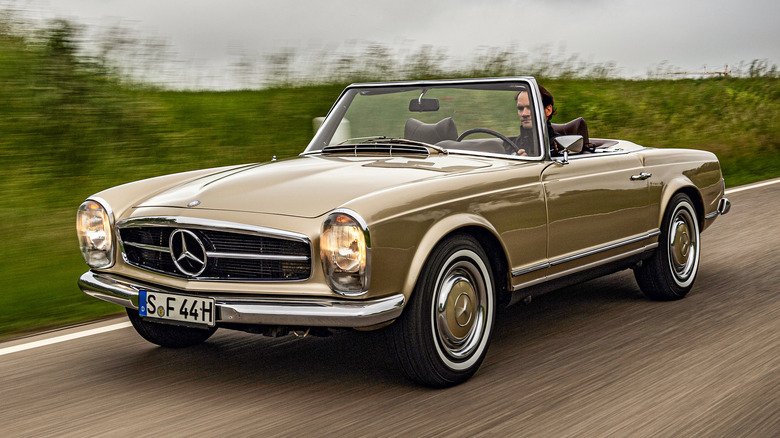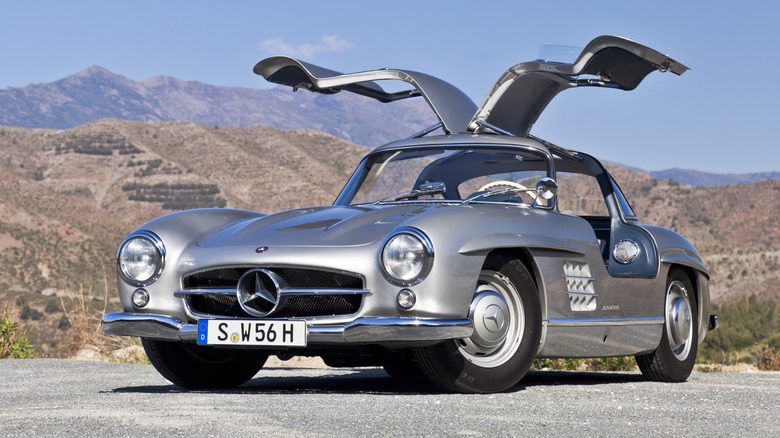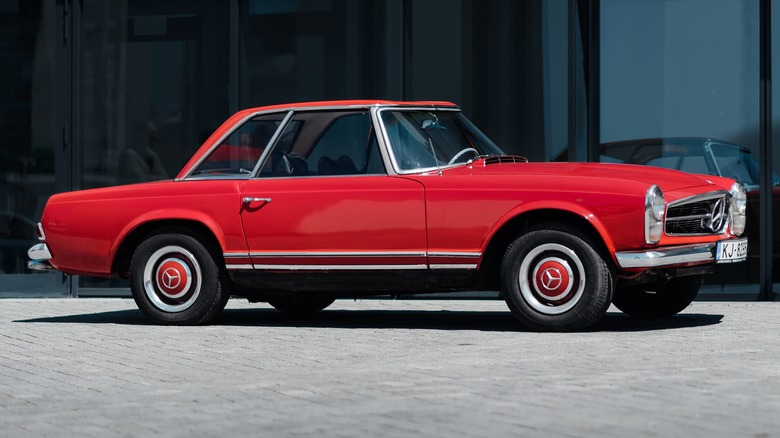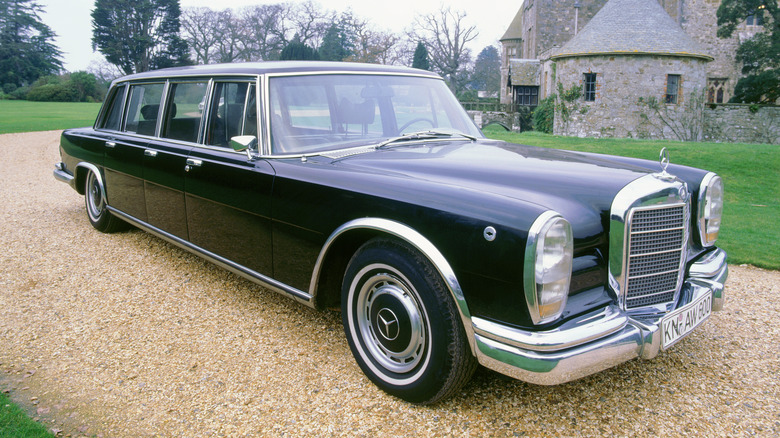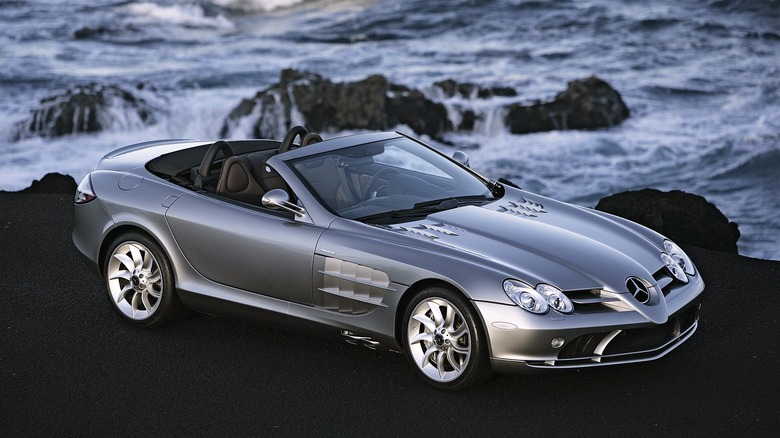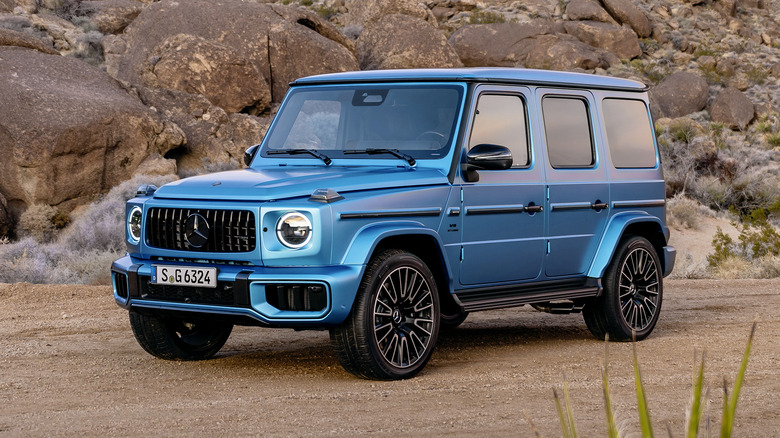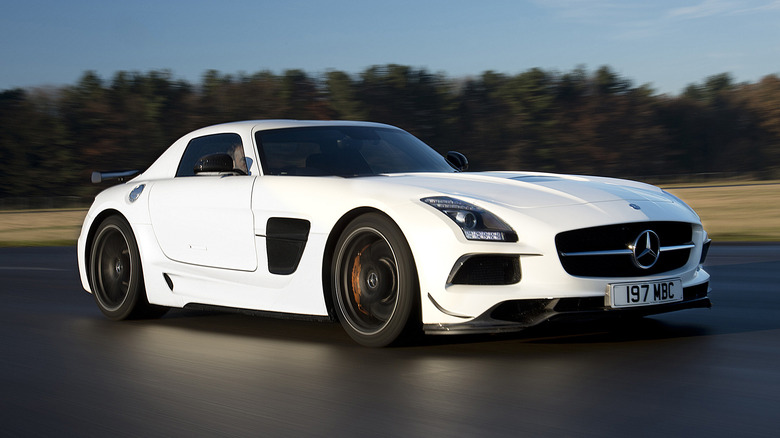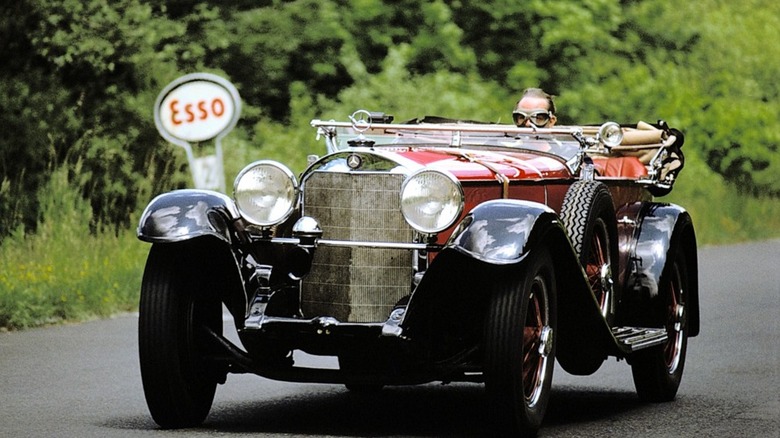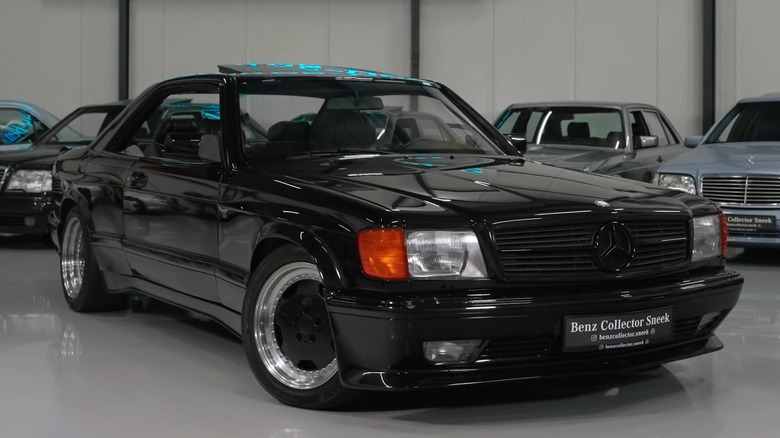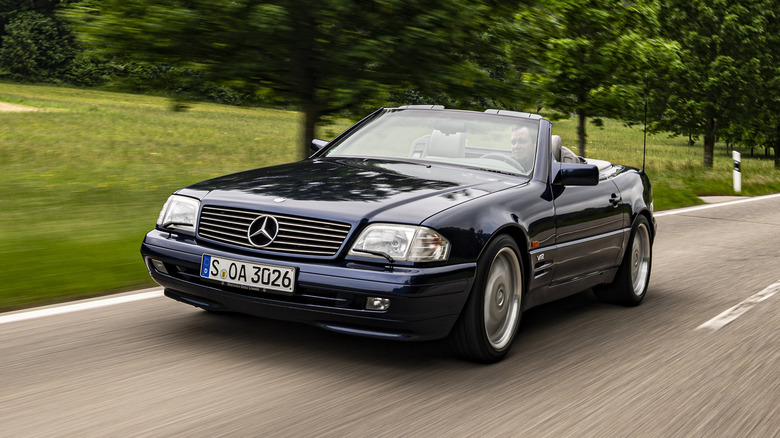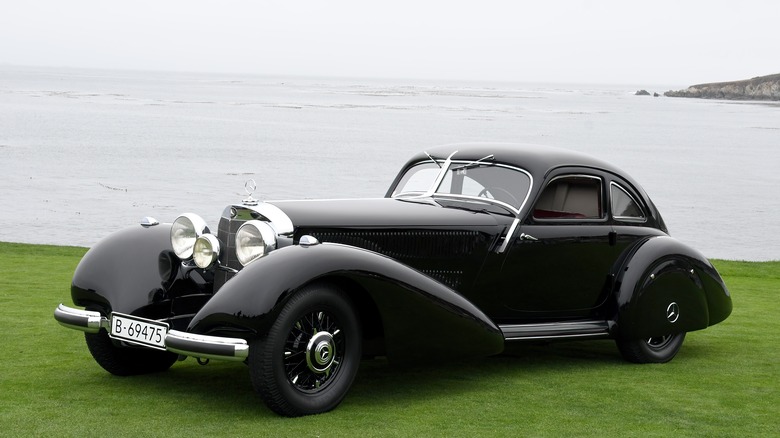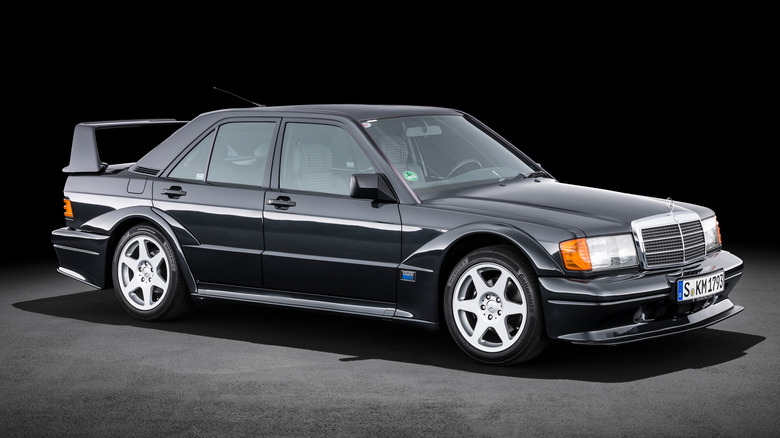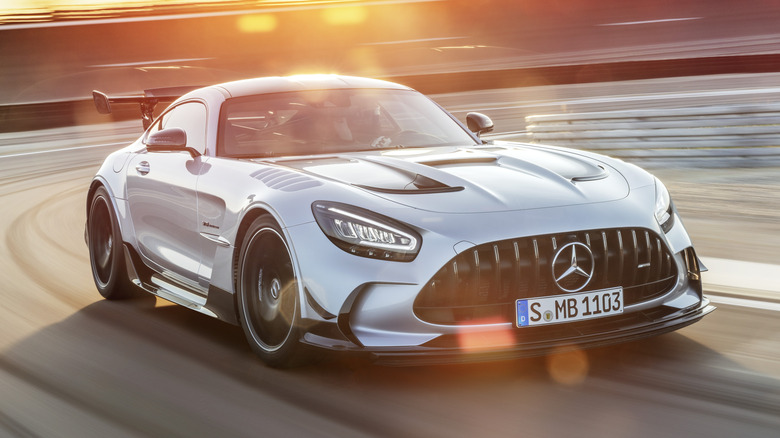The 12 Best Looking Mercedes-Benz Models Ever Designed
With a history stretching all the way back to the earliest days of the automobile, Mercedes-Benz's back catalog is immense. It's best known in America for producing high end luxury automobiles, but elsewhere in the world, it's just as famed for its history of making reliable taxis, everyday family haulers, and commercial vehicles. That breadth of models makes narrowing down the very best looking examples a tricky task.
Including every handsomely styled Mercedes on a list like this would turn it into something closer in length to a novel, and as a result, many good looking cars had to be cut. We think the remaining 12 cars are particularly exceptional examples of Mercedes design, showcasing both the brand's knack for timeless elegance and its rich history of racing-inspired road cars. From the pre-war era to the present day, each one will turn heads at meets, concours events, or on the road — although some of them are fiendishly difficult to see in person.
Mercedes-Benz 300 SL Gullwing
The racing version of the 300 SL had already made its mark on the sports car world by the time an American Mercedes-Benz importer suggested it could be made into a road car. Max Hoffman was an influential figure in North American Mercedes-Benz sales, and his insistence that American consumers would want a sports car with the famous tristar logo was what convinced the automaker's bosses to take a gamble on production. That, and the fact that he ordered 1,000 units on the spot to prove his point.
It would turn out that Hoffman's hunch was right, and buyers were found for every car in the initial production run in only a year. Demand was still strong, however, so production was extended. It helped, of course, that the race-spec 300 SL was still racking up high profile victories at races such as the Mille Miglia, beating competition from the likes of Ferrari and Aston Martin.
The car's sleek handmade body and now-iconic gullwing doors also played a key role in its popularity, but neither were originally conceived with customers in mind. The body shape was simply a matter of aerodynamics, built to give the car an advantage over its racing rivals, and the doors were a byproduct of the car's racing roots. Its spaceframe chassis was designed to save weight, but it was also too high for regular doors to be fitted. In order to fit doors to roadgoing cars without needing to alter the chassis, engineers came up with the gullwing door. Thus, a design icon was born.
Mercedes-Benz SL Pagoda (W113)
Popular with everyone from businessmen to Hollywood celebrities, few cars encapsulated '60s cool as well as the W113 SL. It gained the nickname Pagoda from its unusually styled roof, a name which has since been adopted by Mercedes itself. Initially, however, it was introduced to the world as the 230 SL at the 1963 Geneva Motor Show.
Mercedes wasn't sure its new car would be a smash hit -– in fact the opposite was true, and some regarded it as too much of a compromise. It replaced two wildly different roadsters in the brand's lineup, with one being the race-oriented 300 SL and the other being the luxury 190 SL cruiser. Being plusher and less sharp to drive than the former and sportier than the latter, it might well have made for an uncomfortable middle ground for Mercedes buyers. Thankfully, it didn't.
The Pagoda proved to be the best of both worlds, with its simple yet elegant design looking just as much at home in the winding roads of the French Riviera as it did in the wealthiest neighborhoods of Los Angeles. Buyers loved its engine too, which churned out 150 horsepower in a manner that was remarkably smooth no matter whether it was mated to the four-speed manual or automatic transmission. In the decades since its release, the car has retained a cult following, and examples are still highly sought after by collectors. The most pristine examples can sell for north of $200,000.
Mercedes-Benz 600 Pullman
It might have been out of production for more than 40 years, but the Mercedes-Benz 600 Pullman still remains one of the most imposing limousines ever built. Perhaps it's the car's chrome-heavy design, its sheer size, or perhaps it's the legacy of its owners. Few, if any, other cars have been associated with so many dictators and fascists, with everyone from Idi Amin to Saddam Hussein pictured traveling in one.
The 600 Pullman deserves more than to be remembered as simply a dictator's car though, especially since it was equally popular with celebrities and famous faces across the west. Multiple members of the Beatles owned a 600 Pullman, as did actors like Jack Nicholson. They've proved popular in more recent times too, with Jeremy Clarkson buying a 600 because he was fed up of using his Volvo for the school run. At least, that was his excuse at the time, apparently.
The running costs for the car are notoriously eye-watering, with even a simple switchgear replacement reportedly costing five figures. Part of the cost is down to the car's myriad unique systems, with hydraulics used in place of electrical systems for operating things like the seats, windows, and doors. Only a small handful of specialists know how to work on the systems, and none of them come cheap. The car's history, looks, and infamous costs all add up to something that retains just as much mystique as it did when it left the factory, with Mercedes arguably never managing to make a car quite like it since.
Mercedes-Benz SLR McLaren
Not everyone is sold on the Mercedes-Benz SLR McLaren's looks, with its Formula 1-inspired aero and side exit exhausts, but those that are sold are really sold. Entrepreneur Manny Khoshbin, for example, has eight of them. They're arguably the best looking product to emerge from '00s Mercedes, although much of their styling was a product of a wind tunnel as much as any designer's creative vision. Even the side exhausts were added for practical purposes, as they allow the underside of the car to be as flat as possible, increasing its aerodynamic efficiency.
The SLR occupies an unusual space in both its collaborators' history, in that it was the only McLaren road car between the F1 and the MP4-12C, and is arguably one of the brand's best cars ever. It's also one of the greatest Mercedes cars of its era, boasting unprecedented power and acting as a halo car to attract buyers to lower tiers of the Mercedes lineup. Doing double duty never diminished its appeal, as it's now a hot commodity among collectors of both McLaren and Mercedes cars.
Although it's considered one of the Holy Trinity of '00s hypercars, it's very different to the other two cars that bear the title. Both the Ferrari Enzo and Porsche Carrera GT were sharper to drive and faster on track, while the SLR was more of a hyper-GT — a grand touring car designed for crossing continents at highly illegal speeds. It was unique, but that's exactly what collectors love about it.
Mercedes-AMG G63
In most cases, carmakers don't like to keep their cars looking the same for too long. Conventional wisdom says that, in order to illustrate to buyers the fresh innovations under the hood of a car, there should be a fresh design in which to cloak them. However, the Mercedes G-Class has never subscribed to conventional wisdom. It has remained remarkably similar looking throughout all of its decades on sale, even in 2019 when the whole car was reworked from the ground up mechanically.
The latest generation of the SUV might look like its predecessor then, but it's a very different beast under the skin. The most potent variant of the G-Class is the Mercedes-AMG G63, which is arguably its best looking iteration to boot. SlashGear spent some time with the car in 2020, and found it to be almost exactly as most people imagine it to be -– hilariously powerful, rather obnoxious, and hugely fun to drive.
Sure, the G-Class is available in other markets in more everyday flavors, like the work-ready G350d, but anyone buying the car for style reasons will want to head straight for the AMG. There's something irresistibly illogical about the car — it's about as aerodynamic as a flying brick, yet it's powerful enough to simply beat the air around it into submission and hit speeds once reserved for supercars. It shouldn't work, but it does, and it still turns heads wherever it goes.
Mercedes-Benz SLS AMG Black Series
Sometimes design inspiration comes from unexpected places. The Mercedes-Benz SLS AMG is a prime example: it's been claimed that the car started life as a Dodge Viper — back in the days of DaimlerChrysler — before it was transformed into a Mercedes halo car. That would certainly explain its muscly looks, which appear very different to most other Mercedes cars of the era. Regardless of where Mercedes got its design inspiration from, the SLS AMG is a triumph both in terms of performance and in terms of aesthetics.
The SLS AMG Black Series is arguably the pinnacle of the model, with some additional race-ready aero bits and a more aggressive look overall. The car cost significantly more than a standard SLS AMG, but put the two side by side and it's immediately obvious which one is best. The Black Series' liberal use of carbon fiber and additional vents made it look the part, and its lighter weight and significantly boosted power means it'll leave a regular SLS AMG in the rear view on the track too.
Mercedes-Benz 26/120/180 Type S
It's easy to forget just how far back Mercedes' roots as an automaker go –- by the time the 26/120/180 Type S was unveiled in 1927, the first Benz motor car was already over 40 years old. Its name might not roll off the tongue, but the Type S certainly set tongues wagging when it was first shown off, with its 6.8L inline-six engine producing up to 180 horsepower, a groundbreaking figure for its day. Like many of Mercedes' greatest cars, the Type S attracted a laundry list of high-profile owners at launch, including racing driver Barney Oldfield and writer Sir Arthur Conan Doyle.
Its development was overseen by Ferdinand Porsche long before he established his eponymous rival brand, and was designed to offer the very best in both performance and styling to the most well-heeled customers. Unfortunately, the car debuted right before a global financial depression, and so customers were few and far between. It's thought that just 146 examples were ever built, making this one of Mercedes' rarest cars as well as one of its best looking. Today it's something of a collectors' grail, with one example selling at a Bonhams auction for $5.4 million in 2021.
Mercedes-Benz 560 SEC AMG Wide Body
Back in the late '80s, seeing an AMG badge on a Mercedes was a much rarer occurrence than it is today. The tuning outfit was still independent from the automaker and produced cars in much smaller numbers. It also had complete freedom to add bodykits, bored-out engines, and wild features as it saw fit, which in turn meant each car was eye-wateringly expensive. The 560 SEC AMG Wide Body is one of its most famous creations, and features all three kinds of upgrades. As its name suggests, it was considerably wider than a standard 560 SEC thanks to an AMG-specific body kit, and it was available with added extras like a built-in TV in the center console.
Some cars also had upgraded 6.0L engines, although for some owners the car's stock 5.6L V8 was enough. In bored-out, top-spec form, the car could reach 60 mph from a standstill in less than six seconds, and its speedometer topped out at 199 mph. It was frighteningly fast, then, but also supremely luxurious, with plush leather seats and polished wood trim. Few other cars on the road could match its speed, and none arguably looked as good while doing so. It remains a pricey collectors' car today, with one example selling for around $200,000 at a Bonhams auction in 2021.
Mercedes-Benz SL 600 (R129)
Launched as an all-new replacement to the aging R107, the R129 SL cut a drastically different silhouette to its predecessor. The SL 600 was the top-spec model in the range, featuring Mercedes' 389 horsepower 6.0L V12 engine. Lesser models received a V8 or a six-cylinder engine. The SL 600's styling was still resemblant of the old car to a degree, with its long hood, clean lines, and prominent Mercedes-Benz badging carried over. However, there were some key differences.
The use of chrome was toned down from the '80s car, and the headlights and taillights were a much more contemporary design. The in-car technology was also a world away from the outgoing SL, with everything from the convertible folding roof to the central audio system being thoroughly overhauled. This all came at a significant cost, and as a result, maintenance costs were significantly higher than most other Mercedes models. That means there are plenty of shabby examples around today, but find one in good condition and it'll still draw as much attention on the road as almost any new Mercedes.
Mercedes-Benz 540K Autobahn Kurier
Arguably one of the most beautiful pre-war cars ever built, the Mercedes-Benz 540K Autobahn Kurier was a one-off special based on the 540K grand tourer. Well, technically it's not quite a one-off — two examples were originally built to showcase Mercedes' aerodynamics expertise, but only one survives today. The 540K was already an exceptional car, being designed to appease the brand's most demanding clients. They wanted more power, more comfort, and more technology, and they got all of it.
The 5.4L V8 was capable of hustling the car to triple digit speeds, despite the fact that it weighed nearly 6,000 lb. That made it particularly useful on Germany's newly-built autobahns, a lattice of wide, smooth highways that allowed drivers to commute between cities in record time. The Autobahn Kurier's timelessly stunning looks have been recognized by several sets of judges in the world's most prestigious concours events, most recently in 2021 when the sole remaining example won Best of Show at the Pebble Beach Concours d'Elegance.
Mercedes-Benz 190E 2.5-16 Evolution II
Homologation specials tend to end up in one of two camps. Either they're awkwardly proportioned, hastily converted cars that serve only to fulfill racing regulations, or they're roadgoing performance icons that help define an era of production cars for their manufacturer. The Mercedes-Benz 190E 2.5-16 Evolution II is firmly of the second kind. It wasn't intended to be that way, though, since it was designed to allow Mercedes to enter the DTM championship and therefore built in the minimum number required to meet regulations. A minimum of 500 examples had to be built to enter the series, and so Mercedes built only 502 examples.
The car's 2.3L engine was reworked by Cosworth to churn out 235 horsepower, but the most head-turning change was the wider body and huge rear wing. Both were necessary inclusions on the DTM car for downforce, and so they had to be incorporated into the roadgoing version of the car.
The changes created an outlandish version of what was originally quite a conservative looking sedan, and combined with the car's rarity, that's kept them in high demand with collectors over the decades. The car was originally priced around three times the amount of a base-spec 190E, but buyers will have made a solid return on their investment, as examples today usually fetch more than $250,000 at auction.
Mercedes-AMG GT Black Series (C190)
Although it's since been replaced with a newer model, the first generation of the Mercedes-AMG GT is arguably still the best looking generation of the car. There were several special edition versions produced over its lifespan, but the most visually striking is the AMG GT Black Series. Like other cars in the Black Series lineage, the headline changes center around the car's performance, but it's also been given a visual overhaul thanks to its unique carbon fiber body kit and rear wing.
Its looks don't matter all that much to the driver, at least not when they're getting full use of the 720 horsepower on offer, but for bystanders they make the car even more of an appealing sight. Not only will the AMG GT Black Series be frighteningly fast around a track -– as SlashGear's Chris Davies found out during a test day in Miami -– it'll also be one of the best looking cars at the track too.
